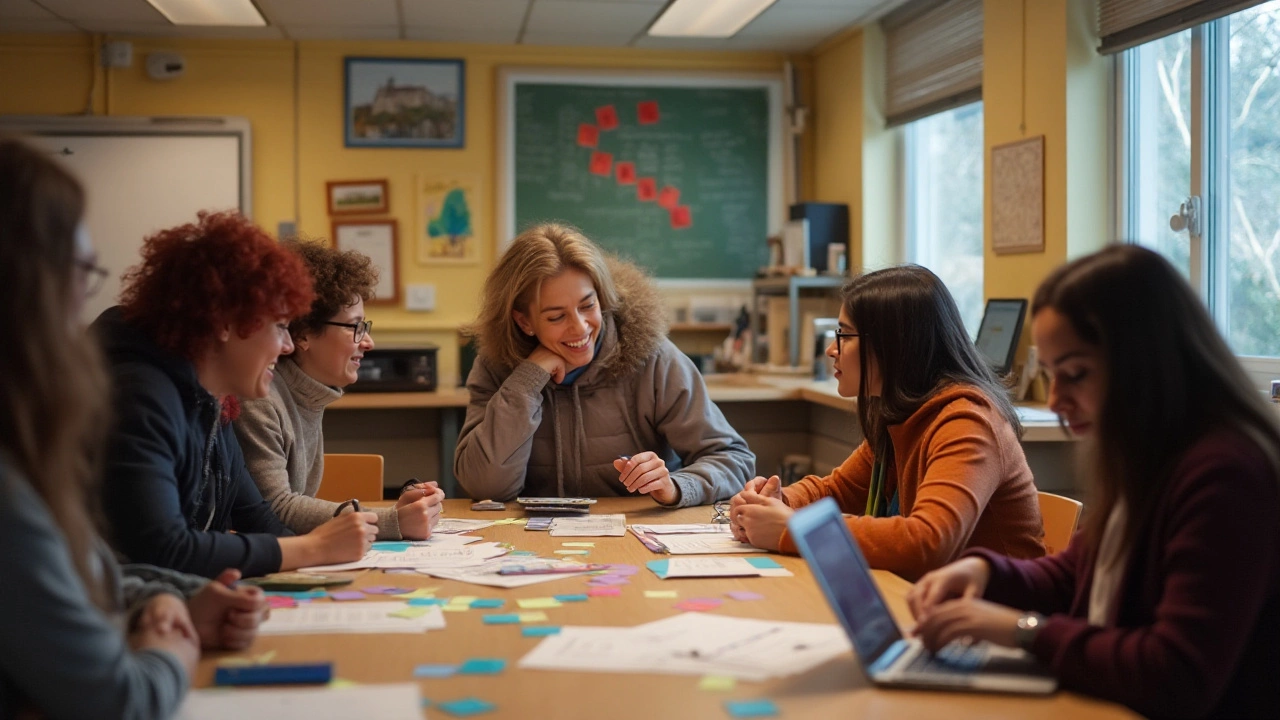Adult education is a dynamic field that requires a special touch. Unlike younger students, adults enter the classroom with a wealth of personal and professional experiences, making their educational needs unique. Understanding which teaching styles resonate with adults can transform their learning journey, making it more engaging and effective.
Adults crave education that respects their existing knowledge while also challenging them in new and exciting ways. As educators, adapting our teaching methods to meet the needs of adult learners requires us to implement strategies that are not only innovative but also grounded in practical reality. This approach not only builds on their past experiences but also empowers them to apply new skills in real-world scenarios.
- Understanding Adult Learning Principles
- Experiential Learning and Hands-On Approaches
- Collaborative and Interactive Methods
- Technology-Enhanced Learning
- Personalization and Flexibility in Teaching
Understanding Adult Learning Principles
Diving into the realm of adult education reveals a fascinating tapestry woven from the threads of life experiences, motivation, and practical application. Unlike traditional schooling, where teachers are often the ultimate authority, adult learning thrives on mutual respect and shared expertise. One fundamental aspect that drives this process is the principle of self-direction. Adults, having navigated through various life circumstances, bring a keen sense of autonomy to their educational pursuits. They are often fueled by intrinsic goals, whether it's advancing a career, mastering a new skill, or indulging in personal growth. Recognizing this self-motivation is instrumental for educators to design courses that resonate deeply with learners.
Another cornerstone of adult education is the need for relevance. Adults are typically pragmatic; they seek direct applications of what they learn to their work or personal lives. This differs markedly from younger students, who may engage with abstract theories without immediate real-world connections. In this context, utilizing case studies, simulations, and problem-solving scenarios can resonate well. Such approaches not only fuel engagement but also ensure the assimilation of knowledge. Kurt Lewin, a pioneering organizational psychologist, famously noted, "Learning is more effective when it is an active rather than a passive process," emphasizing the power of participatory learning environments.
Experiential learning is another significant principle. Adults often seek to connect new knowledge with their extensive life and work experiences. The brain processes new information better when it is pegged onto previous knowledge structures, allowing for richer understanding and long-term retention. Hence, an educator's role involves facilitating platforms where learners can share and reflect on their experiences. This approach often dismantles the traditional teacher-student hierarchy, fostering a collaborative environment where learners feel valued and heard. Moreover, this technique enhances critical thinking as learners view content through the lens of their personal narratives.
Seeking respect and acknowledgement is also crucial for adults; they thrive in environments where learning facilitators recognize their pre-existing competencies. This is the principle of acknowledging the adult learners' self-worth and the unique perspectives they bring to the table. Traditional authoritarian teaching styles are often futile; instead, educators can succeed by nurturing a respectful and inclusive atmosphere. This involves listening actively and incorporating learner feedback to shape the educational journey. One effective way is through personalized feedback, which caters to individual strengths and areas for growth.
The readiness to learn is another principle decidedly important in adult education. Adults exhibit a strong readiness to learn when they perceive a change in their life situation. It's during transitional phases, such as job shifts, parenting, or retirement, that adults seek education to adapt to new roles. Educators can tap into this readiness by offering learning paths aligned with learners' evolving goals. Tailoring education to fit these life stages not only increases relevance but also heightens the motivation to learn. This goal-oriented approach often means adults prioritize education that addresses immediate needs over long-term pursuits.
Lastly, adults learn best when they are internally rather than externally motivated. While commendations and assessments can serve as incentives, genuine engagement often stems from a personal desire to solve a problem or fulfill a personal aim. This intrinsic motivation underpins the adult learning journey, driving perseverance even when challenges arise. By harnessing this motivation and aligning content with learners' intrinsic goals, educators can facilitate a transformative educational experience that empowers and inspires.
Experiential Learning and Hands-On Approaches
Experiential learning has long been revered as one of the most effective teaching styles for adults. The reason is simple: Adults learn best by doing. This approach aligns perfectly with the way our brains are wired. When we actively engage in an experience, our minds are better equipped to retain information. Rather than simply listening to lessons or reading from a text, adult learners dive into hands-on activities that ignite their curiosity. This method not only encourages deeper understanding but also promotes critical thinking. When adults encounter challenges in a controlled environment, they develop problem-solving skills that are essential in real-world applications.
It's fascinating how the principles of experiential learning can be traced back to the educational philosophies of John Dewey. Dewey argued for the integration of experience and education, emphasizing the importance of active learning.
"Education is not preparation for life; education is life itself." - John DeweyFollowing his lead, David Kolb put forth the Experiential Learning Theory, outlining a cyclical model involving concrete experience, reflective observation, abstract conceptualization, and active experimentation. This framework allows learners to build on their knowledge base actively, transforming theoretical concepts into actionable insights. Such methods are particularly effective in adult education, where learners seek to connect theoretical knowledge with practical applications in their professional and personal lives.
Consider a typical classroom setup for an adult learning course focused on business management. Instead of traditional lectures, an educator might use case studies, role-playing, and simulation games. Through these methods, students can immerse themselves in real business scenarios, analyze decisions, and witness the consequences of their actions in a risk-free environment. This encourages the development of strategic thinking and decision-making skills crucial for any manager. Adults are more likely to engage actively and retain lessons when placed in situations that mirror their work environments.
Moreover, technology has given experiential learning a new dimension. Virtual reality and simulation software provide adult learners hands-on experiences without geographic constraints or limitations. For instance, medical students can perform virtual surgeries, mastering techniques without the fear of real-world consequences. Similarly, automotive engineers may use sophisticated software to design, test, and optimize vehicle parts, gaining vital insights from a myriad of virtual tests. A study by PwC found that VR learners were 275% more confident in applying what they had learned after training. Such data highlights the immense potential of technology-enhanced experiential learning in modern adult education.

Collaborative and Interactive Methods
Engaging adults in a learning environment often requires techniques that go beyond traditional lectures. Collaborative and interactive methods provide a dynamic approach to adult education, leveraging the experiences and insights of the learners themselves. One of the most effective ways to achieve this is through group discussions, which encourage participants to share their personal observations, ask questions, and learn from one another. This fosters a sense of community and collective growth, benefiting from the diversity of thought present in adult groups. By creating opportunities for dialogue, educators can transform the learning space into a buzzing hive of ideas and innovation.
Team projects provide another avenue for interactive learning, pushing adults to work together towards a common goal. This collaboration mirrors workplace scenarios, where teamwork is essential to success. By tackling real-world problems within a classroom setting, adults can apply what they've learned in a practical, meaningful way. It’s an approach that not only reinforces the material but also builds on existing skills like communication, leadership, and critical thinking. Educators who implement these strategies often see better engagement and retention among their students, as these methods tap into adults’ desire to contribute and be challenged.
Technology has also revolutionized the way collaborative and interactive methods can be conducted. Tools such as online forums, video conferencing, and collaborative platforms like Google Workspace allow adults to connect and learn from anywhere. These tools facilitate group work and discussions that extend beyond the confines of a traditional classroom, promoting a learning environment that is accessible and flexible. Adult learners benefit from the use of technology as it allows for diverse collaboration, caters to different learning paces, and provides a rich canvas for brainstorming and feedback.
"The way we teach adults must evolve to match the collaborative and interconnected world we live in," says learning strategist Jane Hart. "Incorporating digital tools and ongoing interaction can lead to more meaningful educational experiences."
Role-playing and simulations serve as another layer of interaction, placing adults in hypothetical scenarios that require acquired skills to navigate effectively. These methods not only make learning enjoyable but also encourage adults to think on their feet and apply theory in real-time situations. By observing these techniques in action, educators can pinpoint areas where learners might need additional support or guidance, tailoring content to fit the group's needs more closely.
Finally, providing spaces for feedback and reflection is crucial in a collaborative learning environment. Feedback sessions allow learners to express what worked well and identify areas for improvement, both for themselves and the educational process. Reflection gives everyone a chance to absorb what they've learned, consider societal or personal implications, and think about how they might apply this new knowledge to their own lives. These sessions create an ongoing dialogue between educator and learner, ensuring that both parties benefit from continuous improvement.
Technology-Enhanced Learning
In the evolving landscape of adult education, embracing technology is no longer a novelty but a necessity. The integration of digital tools and platforms into learning environments allows adult learners to access education flexibly and interactively, reshaping the way knowledge is acquired and applied. Today's adults are digital natives, often having grown up alongside technology. This familiarity can be harnessed to create more engaging and personalized learning experiences. From online courses and webinars to interactive simulations and virtual reality, technology can diversify teaching styles, providing rich, immersive learning experiences.
Many online platforms, like Coursera and Khan Academy, offer vast courses aimed at adult learners, covering everything from professional development to hobbies. These platforms allow learners to proceed at their own pace, deciding when and where to engage with the material. Coupled with discussion forums and peer feedback options, adults find a supportive community that enhances the learning experience. A significant advantage of technology-enhanced learning is its ability to cater to different learning preferences. Auditory, visual, and kinetic learners all find resources that cater specifically to their needs, ensuring that each student can absorb material in a way that resonates most with them.
Moreover, advancements in artificial intelligence and analytics enable personalized learning paths. Algorithms track progress and suggest learning materials tailored to individual strengths and weaknesses. Interactive tools, like quizzes and games, help reinforce knowledge in a fun, engaging way. This technology not only responds to how a student learns but also predicts potential areas for future improvement. Having such personal feedback driven by technology motivates adult education seekers by showcasing tangible progress in their educational journey.
According to a study by the Pew Research Center, "72% of adults believe that digital platforms have positively impacted their learning experiences." This shows a favorable trend towards the adoption of technology in education, helping both educators and learners recognize its potential to break traditional learning barriers.
Another facet of technology-enhanced learning is its support for collaboration. Platforms such as Slack, Zoom, or Microsoft Teams allow adults to connect beyond geographical boundaries, fostering international learning communities. These tools facilitate group assignments and discussions, where students share insights and solutions, enriching their understanding through diverse perspectives. This interconnectedness breaks the isolation often associated with online learning, providing a network where adult learners can thrive academically and socially.
For educators, technology offers invaluable resources to develop and deliver content effectively. Learning Management Systems (LMS), like Canvas or Blackboard, streamline the process of course management, grading, and student interaction. Teachers can quickly upload materials, send announcements, and provide feedback without the constraints of physical classrooms. With these platforms, educators also have the opportunity to access diverse teaching aids, from multimedia content to interactive whiteboards. As a result, they can craft curriculum that is not only information-rich but also highly dynamic, catering to the diverse needs of adult learners.

Personalization and Flexibility in Teaching
In the realm of adult education, personalization and flexibility are not merely buzzwords but critical components of effective teaching. Adults often juggle multiple responsibilities, from careers to families, which means their educational pursuits must fit around these obligations. Educators who embrace flexibility and tailor their teaching methods acknowledge the varied backgrounds and preferences of their adult learners. This approach recognizes that adults come with particular needs and expectations, which must be addressed to foster a motivating and supportive learning environment. When educational programs are adaptable, they empower adults to take control of their learning, move at their own pace, and choose content relevant to their personal and professional aspirations.
Personalized learning acknowledges individual differences within the adult learner cohort. By recognizing diverse learning styles, educators can design courses that offer multiple pathways to success. This might include diverse assessment methods, varied instructional materials, and the use of technology to support learners with disabilities. For example, some adults might prefer visual learning aids, such as videos and infographics, while others benefit more from hands-on activities and real-world simulations. This understanding of diversity within learning preferences allows instructors to craft a curriculum that not only meets but exceeds the expectations of their students. Teaching styles must reflect the cognitive and experiential growth that adults are seeking.
Flexibility also extends to the structure and timing of courses. Traditional education models often lose relevance when rigidly applied to adult learners. Institutions have begun to offer evening classes, weekend sessions, and even self-paced online courses to accommodate the busy lifestyles of adults. Many universities and educational platforms offer course credits for life or work experience, acknowledging the value of practical knowledge in professional contexts. This paradigm shift not only provides flexibility but also affirms the learner’s place in the educational journey. As Dr. Stephen Brookfield, an academic focused on adult learning, once said,
"The role of the adult educator is to enter into a learning partnership with the adult learner, to identify the wants and needs of that learner, and to facilitate the learner’s journey toward their own educational goals."
The integration of technology in adult education further enhances personalization. Online platforms, for instance, allow learners to access resources 24/7, providing the freedom to study when it suits them best. These tools enable educators to offer immediate feedback and incorporate innovative methods such as interactive discussions and real-time quizzes. As technology evolves, so too must our strategies in delivering content. A 2023 survey by *The Learning House* found that 68% of adult learners preferred hybrid models of online and in-person sessions, highlighting the demand for both digital engagement and direct interaction. This statistic vividly demonstrates the need for educational systems to adapt in ways that best serve their adult populations.
Ultimately, the goal of incorporating personalization and flexibility into teaching styles is to maintain a learner-centric environment. By doing so, adults feel valued and understood, which significantly boosts their engagement and success. As we continue to advance in understanding adult education, it becomes increasingly clear that embracing these qualities results in a more fulfilling educational experience that prepares adults for both immediate challenges and long-term goals, aligning with the dynamic nature of the world we live in today.






